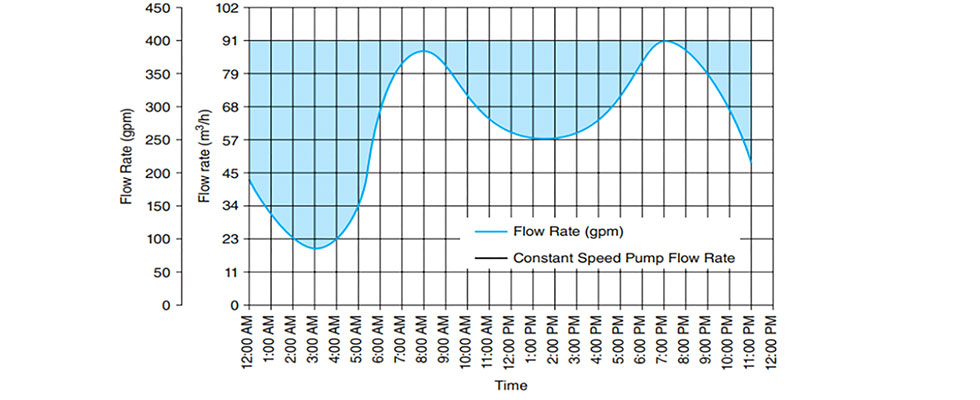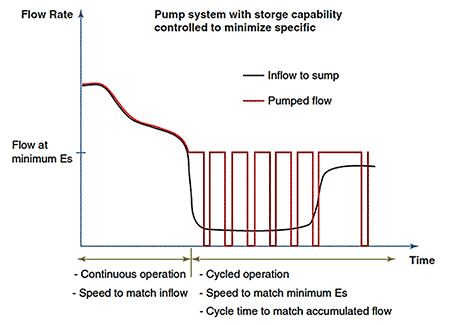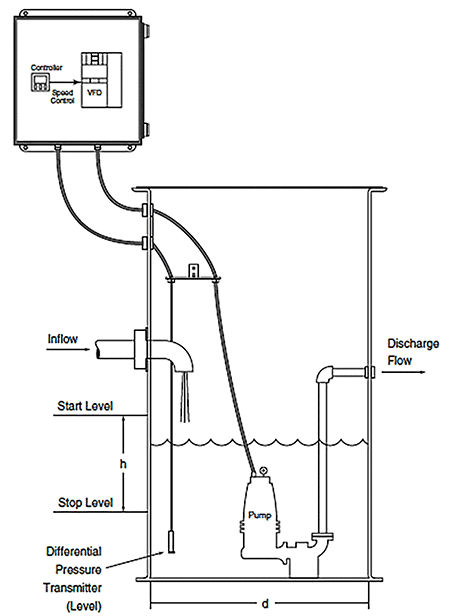
Since stormwater volume is variable, what can be done to optimize efficient pump operation?
Rotodynamic pumps are used in stormwater applications for several reasons, with one of them being that they can operate over a relatively wide flow range. However, these pumps are designed to be most efficient at a specific design flow called the best efficiency point (BEP), and when operated away from BEP, the efficiency will suffer.

Additionally, in stormwater applications, there is a volume that builds in a reservoir, and as the level increases or decreases, the pump(s) may need to be cycled on and off.
For example, if a single pump is sized for the maximum stormwater inlet flow but is oversized for the normal inlet flow, this can result in frequent cycling on/off, which can be inefficient and cause reliability issues. Image 1 provides an example of inlet stormwater flow and also shows the pump flow rate. In this example, the blue shaded area is the difference between the inlet stormwater flow on that day and the pumped flow rate.

The pump is sized appropriately to meet the maximum inlet flow rate of 400 gallons per minute (gpm) but is oversized for the minimum inlet flow rate conditions of 90 gpm. Since the pump is operated at constant speed and the system curve is not varying significantly, it will maintain a nearly constant flow rate and must cycle on and off based on the stormwater reservoir level.
A more efficient, and likely more reliable, way to handle this example would be to have multiple, appropriately sized pumps that are staged to better match the inlet flow rate efficiently or to alternatively utilize variable speed pumping with the single pump, staging it on and off based on minimizing specific energy consumption (Es). Es is the electrical input power per flow rate pumped (kilowatts per gpm).
This is similar to how fuel efficiency of automobiles is represented in miles per gallon; however, the goal of Es is to have the lowest number possible since power consumption is in the numerator.
Examining the variable speed option, Es will decrease as pump speed is reduced, but since stormwater systems have static head, there will be a minimum speed and flow rate that will see Es increase when operated below these factors.

To optimize the control for Es, the variable speed control can match pump flow to inlet flow when it is above the minimum Es flow, operate at minimum Es flow when inlet flow is lower and cycle the pump off when the reservoir level reaches a minimum set point. Modern controls will measure or calculate the inlet flow based on level change of the known reservoir volume to aid in the control.
Image 3 is an example of a variable speed submersible stormwater pump with on/off level control. Image 2 illustrates how the control can be optimized to match the pump flow to the inlet flow when it is above the minimum Es and then maintain this minimum Es flow with cyclic pump operation when the inflow is below the minimum Es.
For more information related to optimizing pump systems, refer to Pump System Optimization: A Guide for Improved Energy Efficiency, Reliability and Profitability at pumps.org.

